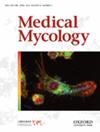Microsporum audouinii: Emergence of an etiological agent of tinea capitis in Rio de Janeiro, Brazil (2012-2019).
IF 2.3
3区 医学
Q3 INFECTIOUS DISEASES
引用次数: 0
Abstract
The etiology of tinea capitis changes over time, mainly due to trends in migration. We report 19 cases of tinea capitis caused by Microsporum audouinii, an uncommon agent in South America, all of them confirmed by molecular methods. All patients were male. The average age was 6.1 years. Fifteen patients were residents of Rio de Janeiro city and four were from neighboring cities. Among the patients submitted to follow-up, griseofulvin was prescribed for eight of them. Due to medication shortages, terbinafine was prescribed for five patients, needing to be switched in three cases, with a bigger total average time until clinical improvement. The study reaffirms the emergence of a new etiological agent in Rio de Janeiro, Brazil.
奥杜因小孢子菌:巴西里约热内卢出现的头癣病原体(2012-2019 年)。
头癣的病因会随着时间的推移而改变,这主要是由于迁移的趋势。我们报告了 19 例由 Audouinii 小孢子菌(一种在南美洲并不常见的病原体)引起的头癣病例,所有病例均通过分子方法确诊。所有患者均为男性。平均年龄为 6.1 岁。15 名患者为里约热内卢市居民,4 名来自邻近城市。在接受随访的患者中,有 8 人使用了格列齐芬。由于药物短缺,5 名患者使用了特比萘芬,其中 3 名患者需要更换处方。这项研究再次证实,巴西里约热内卢出现了一种新的病原体。
本文章由计算机程序翻译,如有差异,请以英文原文为准。
求助全文
约1分钟内获得全文
求助全文
来源期刊

Medical mycology
医学-兽医学
CiteScore
5.70
自引率
3.40%
发文量
632
审稿时长
12 months
期刊介绍:
Medical Mycology is a peer-reviewed international journal that focuses on original and innovative basic and applied studies, as well as learned reviews on all aspects of medical, veterinary and environmental mycology as related to disease. The objective is to present the highest quality scientific reports from throughout the world on divergent topics. These topics include the phylogeny of fungal pathogens, epidemiology and public health mycology themes, new approaches in the diagnosis and treatment of mycoses including clinical trials and guidelines, pharmacology and antifungal susceptibilities, changes in taxonomy, description of new or unusual fungi associated with human or animal disease, immunology of fungal infections, vaccinology for prevention of fungal infections, pathogenesis and virulence, and the molecular biology of pathogenic fungi in vitro and in vivo, including genomics, transcriptomics, metabolomics, and proteomics. Case reports are no longer accepted. In addition, studies of natural products showing inhibitory activity against pathogenic fungi are not accepted without chemical characterization and identification of the compounds responsible for the inhibitory activity.
 求助内容:
求助内容: 应助结果提醒方式:
应助结果提醒方式:


